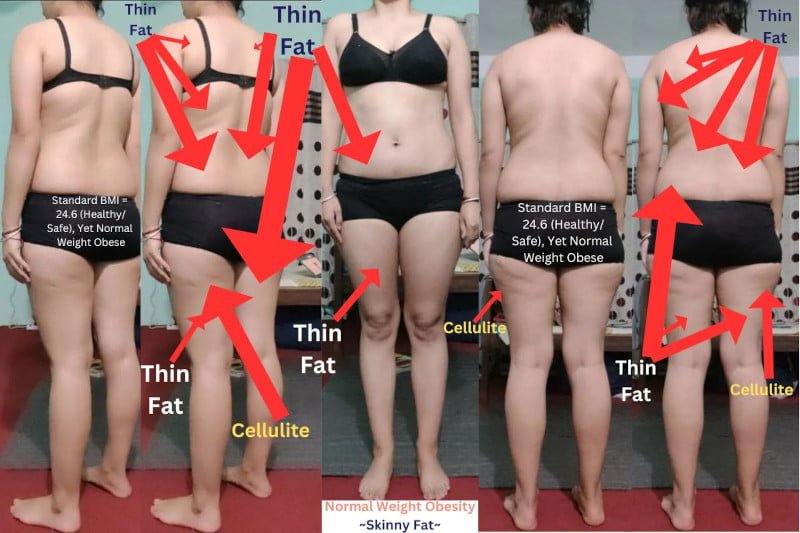Skinny Fat Body Composition – Before & After Weight Loss
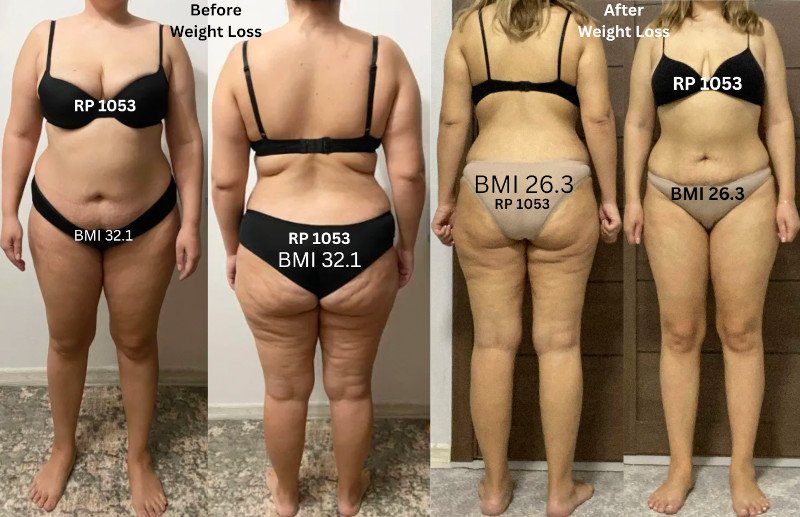

Recent headlines (1, 2, 3, 4, 5, 6) link Ozempic/Wegovy/semaglutide (GLP-1) weight loss drugs to muscle tissue loss, supposedly resulting in a skinny fat body composition. The typical studies referenced (7, 8, 9, 10) use DEXA/DXA scans due to cost-effectiveness, regardless of accuracy, as currently:
“The FDA suggests that only a fraction of participants in Phase 3 trials ought to undergo body composition assessment and the FDA does not require any tests of muscle function, mobility, or strength. Investigations into body composition or muscle-related changes associated with GLP-1RAs are thus limited and likely underpowered and, consequently, the effect on muscle health and function is largely unknown. “
The fact is, DEXA/DXA scans are inaccurate (11, 12, 13, 14, 15, 16) measures of body composition. They cannot discern skinny fat (17, 18, 19), which is different (20) from regular white/yellow fat (body fat %, common adipose tissue). The only technology capable of accurately measuring skinny fat is a specific MRI scan (21).
Skinny Fat Body Composition – Before & After Weight Loss
At this time, there are no scientific studies that use an MRI to accurately determine body composition before and after weight loss. Just as there are no MRI studies that know how much genetic muscle tissue each person had (or did not have) at birth, or ever. The truth is, 99%+ of human beings and their doctors have no idea how much muscle tissue they were born with or without (skinny fat).
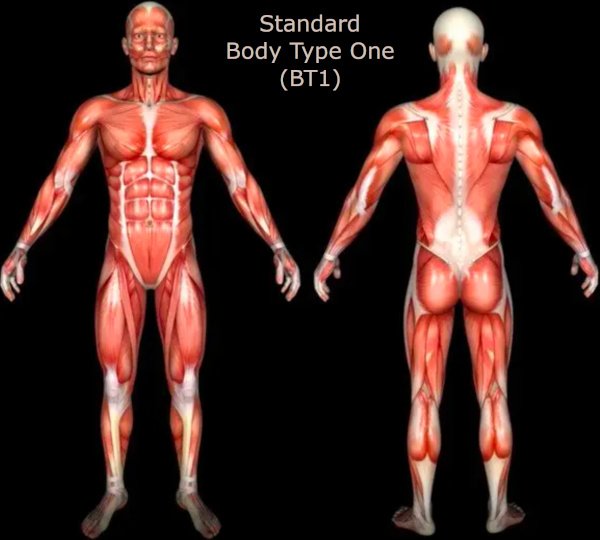
Thus, the typical studies referenced (7, 8, 9, 10) inaccurately ASSUME each person’s level of muscle tissue before and after weight loss:
“Indeed, research has shown that lean mass composition correlates with body weight and varies greatly among individuals.39 In addition, up to 15% of adipose tissue can actually consist of fat-free mass (FFM; which largely consists of lean mass), meaning a large loss of adipose tissue could significantly (and variably) contribute to the overall lean mass loss and inaccurately reflect changes in muscle mass in weight loss trials.39, 40
There is a widely cited ‘rule’ stating the expected loss of FFM for a given amount of body weight loss that is commonly used as a reference for lean mass loss. This rule, called the quarter FFM rule, states that approximately one-quarter of weight loss will be FFM (i.e., ΔFFM/ΔWeight = ∼0.25), with the remaining three-quarters being fat mass. In other words, when an individual loses weight purposefully, it is assumed that approximately 75% of weight is lost as fat mass, and 25% of weight is lost as FFM.
However, an in-depth review of the quarter FFM rule concluded that the rule is at best an approximation, with limited mechanistic basis and questionable accuracy, as the proportion of weight lost as lean tissue varies over time and is determined by multiple factors including level of energy intake, diet composition, sex, baseline adiposity, presence of inactivity or type and level of added activity, and potentially the subject’s metabolic state or hormonal response.41 This observation, together with the variable results of the effects on lean mass from different obesity interventions, leaves us without a proper reference for what should be considered a clinically important amount of lean mass loss during weight loss. Therefore, given the current body of evidence, the clinical significance of the GLP-1-based effects on muscle mass (distinct from lean mass) remains unclear.
Unfortunately, [the] data may not be readily available in the near future. According to the US Food and Drug Administration (FDA) guidelines42 for assessing weight management therapies, the only acceptable primary efficacy endpoints for weight loss drug trials are those related directly to changes in body weight. Body composition metrics such as muscle mass or lean mass, by contrast, are considered safety endpoints, which require far smaller cohorts for testing.”
GLP-1 Drugs & Body Composition – Muscle Loss or Preservation?
Moreover, one study (23) indicates that supposed muscle tissue loss revealed no significant change in physical function — IE muscle function was maintained despite the supposed significant loss of muscle. This suggests that muscle was not actually lost, it was never present to begin with, likely from birth. There are even contradictory studies (24, 25, 26) that indicate that GLP-1 drugs protect against muscle tissue atrophy.
So, what is the reality of body composition, skinny fat, GLP-1 drugs, and weight loss, in general? Basic anatomy deems that lost muscle tissue — from weight loss and/or poor diet, exercise, or/and lifestyle — does not magically become some kind of fat/skinny fat. This is simply not (27, 28, 29) how human tissue works.
If that were true, that lost muscle becomes skinny fat, then it would apply equally to 100% all human beings. Not some, many, or a select few. All. But it does not apply to genetically blessed Christian Bale. Around 2003, he lost a lot of weight for a movie role including obvious muscle tissue:
Yet, even while emaciated at a rough underweight BMI of 16.5 the muscle definition including 6-pack abs and muscle on his love handles, at least, is clear. With no signs of any skinny fat! Genetics.
People who are experiencing skinny fat after weight loss, be it via GLP-1 drugs, a calorie deficit, or the like, were already experiencing skinny fat before they lost the weight.
Before & After Weight Loss – Skinny Fat Body Composition
Research Participant 1053 (30)(RP 1053) started their weight loss journey at an obese BMI of 32.1 with obvious cellulite and thin fat tissue (skinny fat)(17, 19) where default genetic muscle tissue (18) should be but is not:
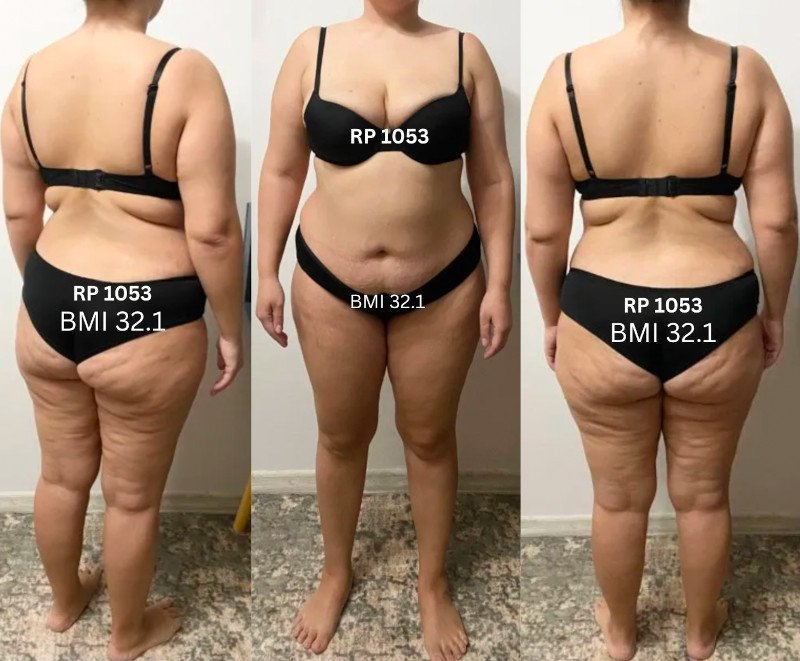
They safely lost weight down to an overweight BMI of 26.3, yet the same thin fat and cellulite tissue (skinny fat)(17, 19) exists in all the same places it did when they were at BMI 32.1. Genetics.
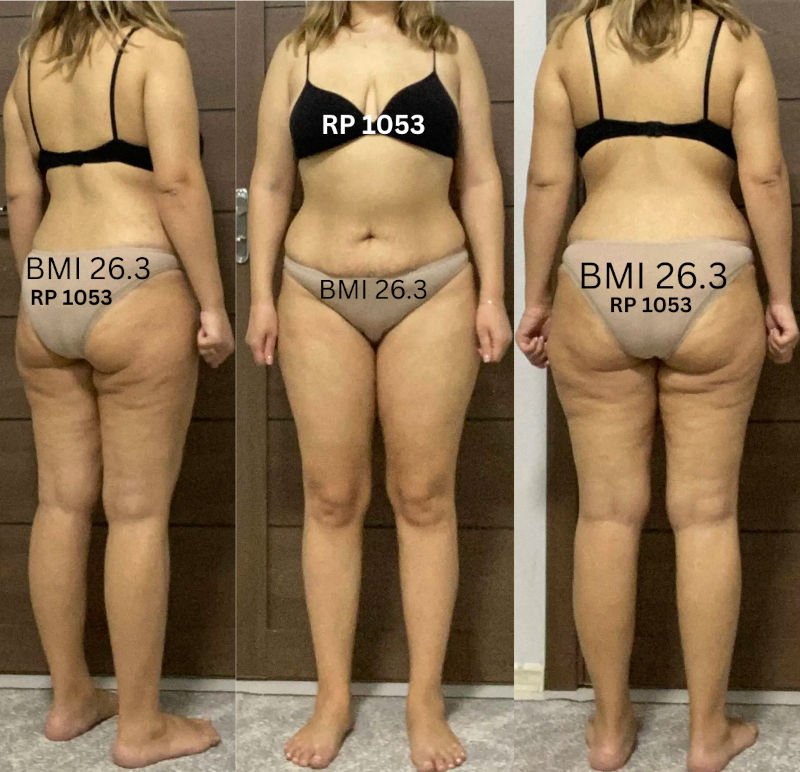
No indications exist that they had the default genetic muscle tissue before they lost weight. And there are no indications that the default genetic muscle tissue was hiding under the excess regular white/yellow fat. Of course, the only way to definitively prove this is with a proper MRI scan, which our Scientific Skinny Fat MRI Study (21) is working on.
Whereas, even when genetically blessed Joe Rogan is overweight he has undeniably defined abs under the excess regular white/yellow body fat. And no skinny fat. Genetics.

Skinny Fat Body Composition is Genetic
Like so many people around the world, RP 1053 never had the default genetic muscle tissue to begin with. They have been experiencing skinny fat (a lack of genetic muscle tissue) from birth, thanks to their unique genetics. We are working on proving this once and for all with our MRI Study (21).
No different than the aforementioned inaccurate scientific studies that claim GLP-1 drugs cause muscle tissue loss and subsequently a skinny fat body composition. People experiencing skinny fat after weight loss were experiencing it always, from birth. There is no evidence that RP 1053 had the default genetic muscle tissue before they lost weight. As well, there is no evidence they lost muscle tissue  during weight loss that somehow magically caused them to become skinny fat.
during weight loss that somehow magically caused them to become skinny fat.
Skinny fat body composition is genetic. The more genetic skinny fat a person is experiencing, the slower (31) their metabolism and the more prone they are to insulin resistance (32, 18, 31), type-2 diabetes (33, 18, 31), being overweight (18, 31, 32, 33), and obesity (18, 31, 32, 33). Are you experiencing skinny fat? Take the Scientific Body Type Quiz to find out.
Best Protein Powder for Skinny Fat
References
- NBC News, Health News: Weight loss drugs can lead to muscle loss, too. Is that a bad thing?, May 20, 2023, Kaitlin Sullivan. https://www.nbcnews.com/health/health-news/weight-loss-drugs-muscle-loss-rcna84936
- BestLife: Ozempic May Cause Dangerous Muscle Loss, Doctors Warn—Here’s How to Prevent That, February 9, 2024, Abby Reinhard. https://bestlifeonline.com/ozempic-muscle-loss-news/
- The Harvard Gazette: Losing fat is good, but losing muscle isn’t, March 18, 2024, Alvin Powell. https://news.harvard.edu/gazette/story/2024/03/losing-fat-is-good-but-losing-muscle-isnt/
- MedicalNewsToday: How to preserve muscle on weight-loss drugs like Wegovy, January 7, 2025, Deep Shukla (Fact checked by Jill Seladi-Schulman, Ph.D). https://www.medicalnewstoday.com/articles/how-to-preserve-muscle-mass-on-weight-loss-drugs-like-wegovy
- The Lancet, Diabetes & Endocrinology: Muscle matters: the effects of medically induced weight loss on skeletal muscle, Volume 12, November 2024, Issue 11p785-787, Carla M Prado, Stuart M Phillips, M Cristina Gonzalez, Steven B Heymsfield. https://www.thelancet.com/journals/landia/article/PIIS2213-8587(24)00272-9/abstract
- The Hill, Health Care: Ozempic can lead to muscle mass loss: Study, November 9, 2024, Ashley Soriano and Markie Martin. https://thehill.com/policy/healthcare/4981015-ozempic-muscle-mass-loss-study/
- Diabetes, Obesity, and Metabolism: Changes in lean body mass with glucagon-like peptide-1-based therapies and mitigation strategies, June 27, 2024, Ian J. Neeland MD, Jennifer Linge PhD, and Andreas L. Birkenfeld MD. https://dom-pubs.onlinelibrary.wiley.com/doi/10.1111/dom.15728
- Drugs.com: Does Ozempic cause muscle loss and how to prevent it?, February 2, 2025, Official Answer by Drugs.com (Medically reviewed by Leigh Ann Anderson, PharmD.). https://www.drugs.com/medical-answers/ozempic-cause-muscle-loss-how-you-prevent-3578660/
- The New England Journal of Medicine: Once-Weekly Semaglutide in Adults with Overweight or Obesity, February 10, 2021, Volume 384, Number 11, Once-Weekly Semaglutide in Adults with Overweight or ObesityJohn P.H. Wilding, D.M., Rachel L. Batterham, M.B., B.S., Ph.D., Salvatore Calanna, Ph.D., Melanie Davies, M.D., Luc F. Van Gaal, M.D., Ph.D., Ildiko Lingvay, M.D., M.P.H., M.S.C.S., and Barbara M. McGowan, M.D., Ph.D. https://www.nejm.org/doi/full/10.1056/NEJMoa2032183
- Healthline: Ozempic Can Cause Major Loss of Muscle Mass and Reduce Bone Density, May 2, 2023, Cathy Cassata (Fact checked by Jill Seladi-Schulman, Ph.D). https://www.healthline.com/health-news/ozempic-muscle-mass-loss
- NIH, National Library of Medicine: Dual-Energy X-Ray Absorptiometry: Research Issues and Equipment, 1997, Wendy M. Kohrt. https://www.ncbi.nlm.nih.gov/books/NBK233779/
- NIH, National Library of Medicine: Comparison of DXA and CT in the Assessment of Body Composition in Premenopausal Women With Obesity and Anorexia Nervosa, March 25, 2013, Miriam A Bredella, Reza Hosseini Ghomi, Bijoy J Thomas, Martin Torriani, Danielle J Brick, Anu V Gerweck, Madhusmita Misra, Anne Klibanski, and Karen K Miller. https://pmc.ncbi.nlm.nih.gov/articles/PMC3607308/
- Wikipedia: Dual-energy X-ray absorptiometry, https://en.wikipedia.org/wiki/Dual-energy_X-ray_absorptiometry
- Nature, Scientific Reports: Changes in DXA-derived lean mass and MRI-derived cross-sectional area of the thigh are modestly associated, July 11, 2019, Dallin Tavoian, Kwasi Ampomah, Shinichi Amano, Timothy D. Law, and Brian C. Clark. https://www.nature.com/articles/s41598-019-46428-w
- UC Davis Health, Sports Medicine: DXA body composition analysis, https://health.ucdavis.edu/sports-medicine/resources/dxa-info
- Journal of Applied Physiology: Percent body fat via DEXA: comparison with a four-compartment model, February 1, 2003, Grant E. van der Ploeg, Robert T. Withers, and Joe Laforgia. https://journals.physiology.org/doi/full/10.1152/japplphysiol.00436.2002
- Skinny Fat Science: What Is Skinny Fat?, July 26, 2024. https://skinnyfat.fellowone.com/skinny-fat-science/what-is-skinny-fat/
- Skinny Fat Science: Is Muscle/Mass Genetic and How Does It Affect Skinny Fat?, November 20, 2024. https://skinnyfat.fellowone.com/skinny-fat-science/is-muscle-mass-genetic-and-how-does-it-affect-skinny-fat/
- Skinny Fat Science: Is Skinny Fat Genetic?, November 27, 2024. https://skinnyfat.fellowone.com/skinny-fat-science/is-skinny-fat-genetic/
- Skinny Fat Science: Are Regular Fat and Skinny Fat the Same Thing?, August 28, 2024. https://skinnyfat.fellowone.com/skinny-fat-science/are-regular-fat-and-skinny-fat-the-same-thing/
- Skinny Fat Science: Scientific Skinny Fat MRI Study – Proving What Skinny Fat Is, March 26, 2025. https://skinnyfat.fellowone.com/skinny-fat-science/scientific-skinny-fat-mri-study-proving-what-skinny-fat-is/
- Britannica: human muscle system, October 22, 2024, Bernard Wood and Robin Huw Crompton (Fact-checked by Editors of Encyclopaedia Britannica). https://www.britannica.com/science/human-muscle-system
- NIH, National Library of Medicine: Effects of Semaglutide on Muscle Structure and Function in the SLIM LIVER Study, February 24, 2025, Grace L Ditzenberger, Jordan E Lake, Douglas W Kitch, Amy Kantor, Raja Muthupillai, Carlee Moser, Pablo F Belaunzaran-Zamudio, Todd T Brown, Kathleen Corey, Alan L Landay, Anchalee Avihingsanon, Fred R Sattler, and Kristine M Erlandson. https://pubmed.ncbi.nlm.nih.gov/39046173/
- NIH, National Library of Medicine: GLP-1RA Liraglutide and Semaglutide Improves Obesity-Induced Muscle Atrophy via SIRT1 Pathway, August 15, 2023, Jie Xiang, Liyan Qin, Jinling Zhong, Ning Xia, and Yuzhen Liang. https://pubmed.ncbi.nlm.nih.gov/37602204/
- ScienceDirect: GLP-1 receptor agonists, body composition, skeletal muscle and risk of sarcopaenia: from promising findings in animal models to debated concern in human studies, September 2025, Volume 51, Issue 5, André J. Scheen. https://www.sciencedirect.com/science/article/abs/pii/S1262363625000758
- Drug Discovery & Development: Evidence on GLP-1 drugs and muscle loss remains murky, November 27, 2023, Brian Buntz. https://www.drugdiscoverytrends.com/glp-1-impact-lean-mass/
- Healthline: Does Fat Turn into Muscle? What to Know, March 2, 2021, Katey Davidson, MScFN, RD, CPT (Medically reviewed by Jake Tipane, CPT). https://www.healthline.com/nutrition/does-fat-turn-into-muscle
- NIH, National Library of Medicine: Muscle-to-fat interaction: a two-way street?, January 1, 2010, Bente K Pedersen. https://pmc.ncbi.nlm.nih.gov/articles/PMC2821541/
- The New York Times: The Claim: Muscle Turns to Fat When You Stop Working Out, July 26, 2006, Anahad O’Connor. https://www.nytimes.com/2005/07/26/health/nutrition/the-claim-muscle-turns-to-fat-when-you-stop-working-out.html
- Fellow One Research: Body Type Test (Quiz) Results 1053 – Body Type Four (BT4) Female (Woman), Millennial (Generation Y). https://www.fellowone.com/fellow-one-research/the-four-body-types/body-type-quiz/body-type-test-quiz-results-1053-body-type-four-bt4-female-woman-millennial-generation-y/
- Skinny Fat Science: How Skinny Fat Affects Metabolism, August 7, 2024. https://skinnyfat.fellowone.com/skinny-fat-science/how-skinny-fat-affects-metabolism/
- Skinny Fat Science: Skinny Fat & Insulin Resistance, June 4, 2025. https://skinnyfat.fellowone.com/skinny-fat-science/skinny-fat-insulin-resistance/
- Skinny Fat Science: How the Skinny Fat Crisis Affects the Global Obesity Epidemic, September 25, 2024. https://skinnyfat.fellowone.com/skinny-fat-science/how-the-skinny-fat-crisis-affects-the-global-obesity-epidemic/


